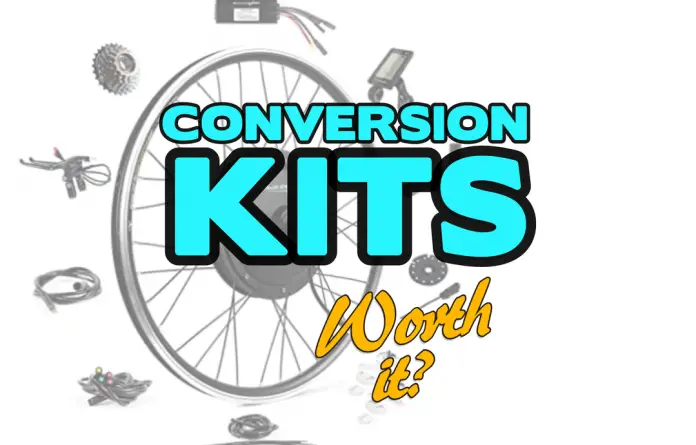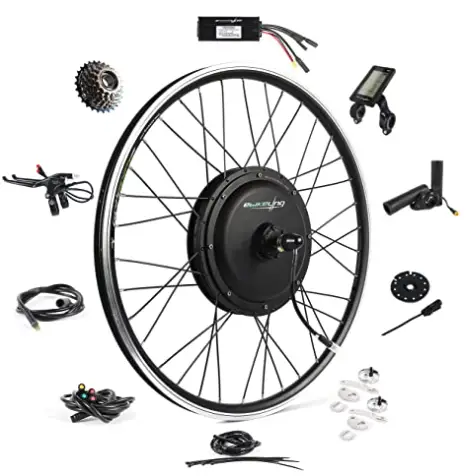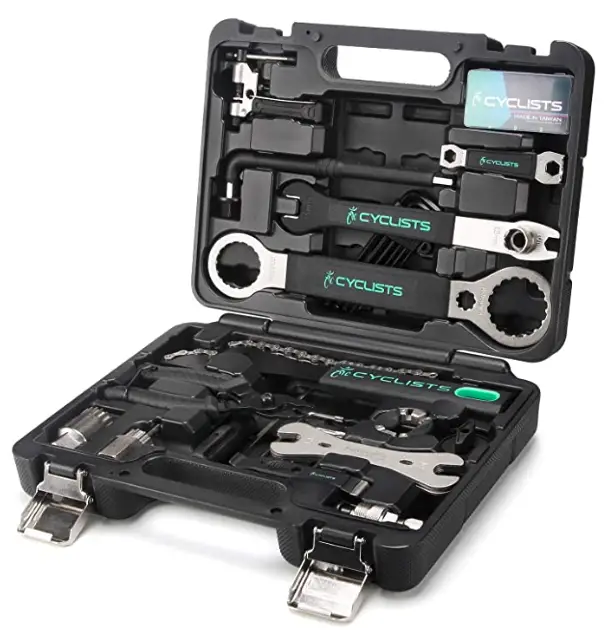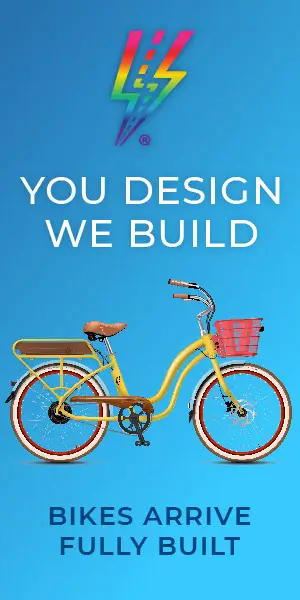The e-bike may seem to be a modern invention, but the concept has been around since the 1890s. Technology has changed significantly since then, which is why they have seen sudden popularity in recent years. Commercial e-bikes are readily available, but you also have the option to use a kit to convert your existing bicycle to an e-bike.
But how do these e-bike kits compare, and are they worth the cost?
An electric bike conversion kit is typically worth the money. Kits are cheaper than buying a new e-bike. This lets you put more money into buying a more powerful, better-quality conversion kit. Conversion kits are typically easy to install with only a few tools and even new e-bikes often require some assembly.
The newer technology used in e-bikes has allowed conversion kits to improve, allowing anyone to turn their standard bicycle into an e-bike. You have a wide range of conversion kits to choose from, depending on your cycling needs.
Plus, conversion kits have some advantages over getting a new e-bike, but some disadvantages may convince you to go the new e-bike route.
Check out the table to see Electric Bike Conversion Kit pros and cons. Then continue reading to get the specific details as well as discover the pros and cons of buying a factory (brand name) e-bike.
| PROS | CONS |
Why Choose an E-Bike Kit Over an E-Bike?
The concept of an e-bike may be appealing to you, and an e-bike has many benefits and advantages in a wide range of applications. From commuting to recreation, an e-bike can revolutionize the way your use a bicycle.
Which would be the best route to acquiring an e-bike? Is buying a conversion kit the way to go, or is a factory-produced, branded e-bike a better choice?
There are many different types of e-bike conversion kits, each with its own benefits, strong points, and weaknesses. I’ll show you the different options for conversion kits, but first, let’s look at why a kit may make more sense for you than buying a new electric bike.
Pros Of An E-Bike Conversion Kit
The advantages to choosing the conversion kit route to turn your existing bicycle into an e-bike are many, but some points will be less important to some people than others. However, most of the advantages make a compelling argument in favor of conversion kits.
- You keep your original bike. If you have recently purchased a regular bicycle or don’t want to part with your old bike, you don’t need to sell it or store it. You simply buy the kit and perform the conversion on your old bike. This has implications for the cost factor of e-bikes.
- A conversion kit is generally cheaper, but not always. The cost of the bike (frame and tires) is a large component of the cost of a new e-bike. With a conversion kit, this cost is no longer relevant since you already own the bike.
Conversion kits vary in price depending on the type and power of the kit, but they can be less than half the cost of a factory e-bike. However, if your bike is expensive and you want a good kit, the price of the kit and a professional installation can quickly rack up to be similar to the cost of a new electric bike (although of lower quality). - Customize your e-bike to your needs. A kit allows you to build your electric bike to your needs and you can customize parts to match without replacing the entire kit or bike if your needs change.
- Easy removal of the conversion kit. You can remove the kit from your bike to restore it to its original condition or install the kit on a different bike.
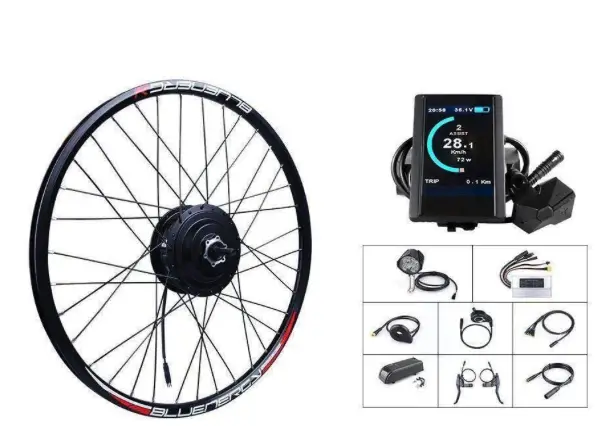
Cons Of An E-Bike Conversion Kit
As with any after-market, add-on product e-bike conversion kits can have some disadvantages, which may be a deciding factor in your considerations regarding kits. And of course, it’s important to remember that conversion kits vary depending on the type of electric bike conversion that’s being done.
- Mechanical aptitude is required. Conversion kits are easy to install, but you need to have some degree of mechanical aptitude (or spend a lot of time reviewing helpful videos) to complete the conversion.
- Messy wiring. Depending on the type of e-bike conversion kit you select, there may be many wires that you need to neaten up and try to hide. Standard bicycles do not hide this wiring well because they are not designed for it.
- Added weight. The kit and the batteries add weight to the bicycle, making it difficult to carry on subways or up a flight of stairs (or even just to put in the car).
- Weight distribution on the bicycle. A conversion kit is an add-on that changes the weight distribution and the feel and control of the bike. If the weight of the kit is not positioned correctly, it could affect the e-bike’s stability.
- Safety of the kit. There have been some reports of conversion kits, particularly the batteries, catching fire and causing explosions. However, this is mainly if they are not properly installed or have inadequate protection.
- Brakes and tires may need upgrades. Depending on the conversion kit, you may need to upgrade the tires and brakes on your bicycle for compatibility with the conversion kit.
- Some kits do not come with a battery. Many kits are not sold with the battery included… and batteries are one of the most expensive parts of an electric bike.
- Better technology in factory e-bikes. In general, factory e-bikes come with more bells and whistles integrated into the bike, such as GPS functionality.
Pros Of A Factory e-Bike
Factory-built electric bikes are a popular choice for transitioning to commuting from driving a car, protecting the environment from gas emissions, recreation, and exercise. The growing popularity shows that buying a new e-bike can have merit over using an electric bike conversion kit.
- The e-bike is purpose-built. The factory e-bike is designed to fit all the components in the bike in an ergonomic and balanced way. Thus, there are no weight imbalance issues or exposed wiring.
- Better aesthetics. New e-bikes don’t look like a DIY job. And with many models, including those like the Ride1up brand with batteries integrated into the frame, you have to look very closely to see that it is an electric bike. In fact, having an integrated battery helps protect the components as well.
- Factory warranty. The factory warranty and after-sales service and support are a peace-of-mind factor should things go wrong.
- Better speed and functionality. Brand-name e-bikes generally perform better than bikes converted with a kit. Factory bikes also have more built-in functionality and perks to get you to buy. This might include a better controller with an LCD display, headlight, bike bell, USB port for your cell phone, etc.
- Better quality batteries. The batteries incorporated into factory e-bikes are generally higher-quality lithium batteries from well-known manufacturers. The batteries will provide more power and last longer than most electric bike conversion kit batteries.
- More robust, lightweight frames. Factory e-bike frames are designed to carry the extra weight of the motor and batteries. The frames are strengthened in strategic locations for the additional weight. In some cases, the frames are made from lighter materials to counteract the weight of the extra equipment.
Do you need a dual mode controller? Read here before buying!
Ride1Up e-bikes, like this one, already have a frame built for the extra weight and bulk of the motor and battery. As an added feature, the rechargeable battery is built into the frame so it’s hardly noticeable:
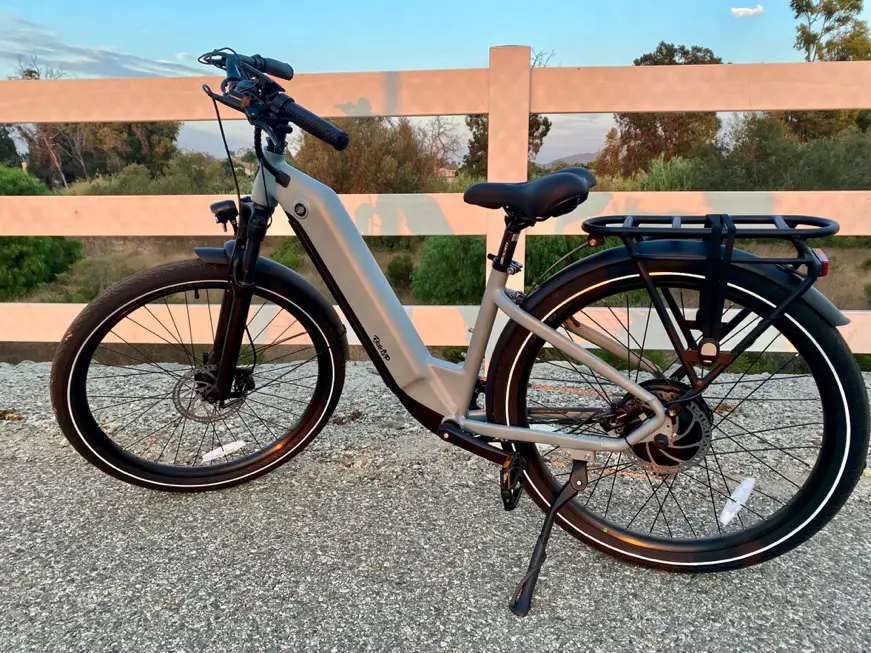
Cons Of A Factory e-Bike
There are some disadvantages when opting for a factory e-bike, but if your cycling needs are straightforward and don’t change much, the cons against this choice may be less of an influence on your choice.
- New electric bikes are expensive. Factory e-bikes of about 250W-350W typically have a starting price of between $800 and $1000. More powerful bikes in the 500W range cost between $1200-$1500 and up. The most powerful e-bikes allowed on roadways in the US are 750W, and they generally cost between $1200 and $2000 on the low end.
Thankfully, however, there are many well-known and respected brands, such as Rad Power Bikes or Aventon that have high-quality, affordable e-bikes. - Expensive replacement parts. Once the warranty on the electric bike has expired, spare parts and maintenance can be expensive.
- Difficult to upgrade. Purpose-built e-bikes have all the components built into the bike and may only accept parts from the same manufacturer. Changing parts like the battery to gain more power may not be possible.
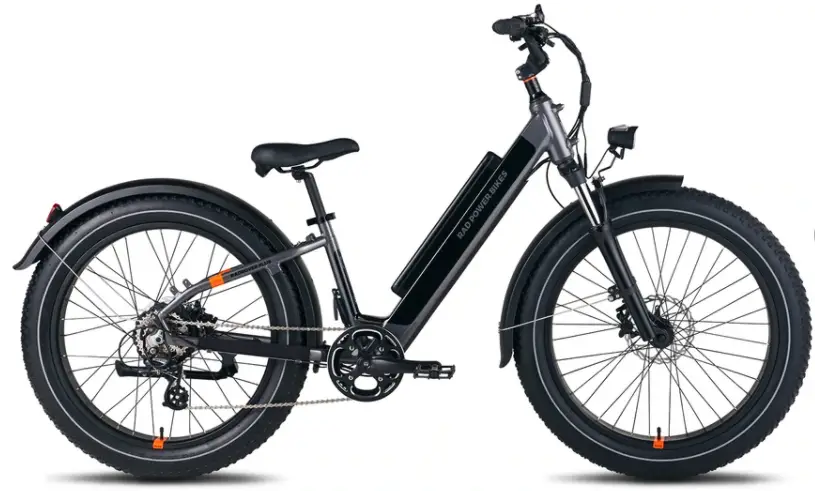
Ready to do an e-bike conversion? Check out this guide!
Types Of Hub Motor Conversion Kits
There are multiple types of e-bike conversion kits, and the choices will vary in price and features. The various types all have different strengths and weaknesses. We’ll cover the different kits briefly to give an overview of the styles and their suitability.
There are two main types of e-bike conversion kits: hub motors and mid-mount motors. There are sub-types of these categories which determine how the motors work.
Hub Motor E-Bike Conversion Kits
Hub motor conversion kits are one of the main types of electric bike conversion kits available and are some of the easiest types of kits to fit onto your existing bike. Many conversion kits use this type of motor.
As the name suggests, the motor is fitted to the wheel’s hub and the kit usually comes with the wheel. It’s important to get a kit with the same wheel size as your existing wheel, or you may need to replace the opposite wheel with a matching size.
The sub-categories in this group are direct hub drive motors, geared hub drive motors, front-wheel hub motors, and rear-wheel hub motors.
Direct Drive Hub Motor Kits
Direct-drive hub motors are basic and simple, incorporating the motor into the hub of the wheel. When the motor is operating, it turns the wheel directly as opposed to using a geared mechanism. The design is simple, making it easy to install and maintain.
The main negative of these motors is that they need to be large to generate enough power to drive the bike. Smaller versions would not have enough power to be useful, especially at low speeds.
The main advantage of these types of motors is that they are relatively cheap in comparison to some of the other motor types. Another positive is that direct drive hubs are very reliable due to the simplicity of the motor.
Here’s a direct drive hub motor for a front or rear wheel from Ebikeling that costs under $500 on Amazon:
Geared Hub Motor Kits
Geared hub motor e-bike conversion kits are smaller than direct-drive hub motors and generally more efficient. This kind of motor uses a planetary gear reduction system to connect to the motor’s stator.
This gearing system means that for every rotation of the bike’s wheel, which is essentially the motor’s case, this hub motor spins many more times.
This increases the motor’s speed and efficiency and allows a smaller motor to produce more energy.
The main benefits of these motors are that they are small, fast, and relatively maintenance-free compared to the other motor types. One of the main benefits of this motor type is that if the battery pack goes dead, you’ll feel very little resistance on the pedals, and you can ride the e-bike as if it were a normal bike.
The planetary gearing system does experience wear, particularly when carrying heavy loads or cycling many hills. However, nylon gears are cheap and easily replaced.
Front Hub Motor Kits
As the name suggests, front hub motor conversion kits are on the hub of the front wheel. The drive can be either a direct drive or a small geared motor.
The best choice is a geared motor due to its smaller size, making less impact on the steering and control of the bike due to its lightweight characteristics.
Direct drive motor conversion kits can be fitted to the front wheel are cheaper and produce more torque, but the heavier weight on the front wheel can be a little disconcerting till you become accustomed to it.
Front hub motor kits have an advantage in that they provide two-wheel drive when the motor is engaged. You power the back wheel by pedaling and the motor powers the front wheel.
The disadvantage of a front hub kit is that they are not great for off-road riding, particularly on rough or sandy steep hills where they tend to spin and lose traction.
Check out the best e-bikes for sand!
Rear Hub Motor Kits
Rear hub e-bike conversion kits are fitted on the rear wheel of the bike. They can also be direct drive or geared motor types.
They are more complicated to install on the bike than a front hub motor because you have to remove your gear cassette from your original wheel and mount it on the wheel that comes with the kit. You may need additional, specialized tools (Amazon) to get this conversion done.
The main disadvantage of a rear hub motor is that it is considerably more difficult to repair punctures on the back wheel with the motor installed. It can be done, but it takes longer.
Mid-Drive Motor Conversion Kits
Mid-drive e-bike conversion kits are some of the more expensive versions but also the most popular. This type of motor is the most efficient variety and produces much more power and low-end torque than either of the hub motor types.
This type of motor is fitted in the middle of the bike near the pedals. The main difference in this type of configuration is that the motor drives the pedals rather than the wheels.
The main disadvantage of this kit is that the installment is considerably more complex than the hub motors. It’s also not compatible with all bicycle types. Only bikes with threaded pedal axle brackets of a certain size can accept this type of e-bike conversion kit. This makes it important to buy the right kit for the bike you’re going to convert.
The mid-mount motor also does not allow for a double front cog on the pedals, and when the motor is not working, there will be significant resistance felt in the pedals. Mid-mount motors also require more maintenance than hub motors.
You’ll probably also need additional tools to complete this conversion, such as this wrench.
Example of a mid-drive motor conversion kit (Amazon) and included parts:
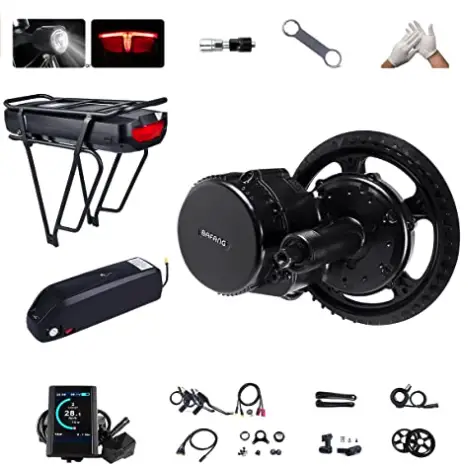
Why Are Electric Bike Kits So Expensive?
The prices of e-bike conversion kits will vary depending on the motor’s style and the motor’s power rating. So, are they worth the money?
Direct-drive hub motors are the cheapest kits, ranging from $200 to $350. Geared hub drive motor conversion kits range in price from $300 to $500. Mid-drive conversion kits are some of the most expensive and can range in price from $500 to $1200.
E-bike conversion kits are somewhat pricey because of the electronic components and motors incorporated in the kit. The kit usually consists of the motor, which in the case of a hub motor is an entire bicycle wheel, a controller for the motor which contains sophisticated electronics, and the wiring and connectors.
Many kits are not sold with the battery included in the price. If the battery is not included, you can budget an additional $200 to $600 for the battery, depending on the battery size, capacity, and quality.
So buying an electric bike conversion kit is typically worth it, unless you are buying the most expensive mid-drive kit and high-powered battery.
Conclusion
Conversion kits to convert a regular bicycle into an electric bike can be cheaper than buying a new factory e-bike, but there are always trade-offs.
Some e-bike conversion kits will work well, and others may be problematic, especially if you get a kit that is not exactly compatible with your existing bike.
For this reason, many people who use conversion kits take their bikes to a bike shop to get the right kit and get it fitted correctly to the bike. This will increase the costs but it will also save time and frustration in trying to do it yourself.
Conversion kits are worth the cost if you don’t mind building your bike into an electric bike. But if you can afford it, a factory e-bike will typically outperform a kit bike in terms of performance, reliability, and features.

